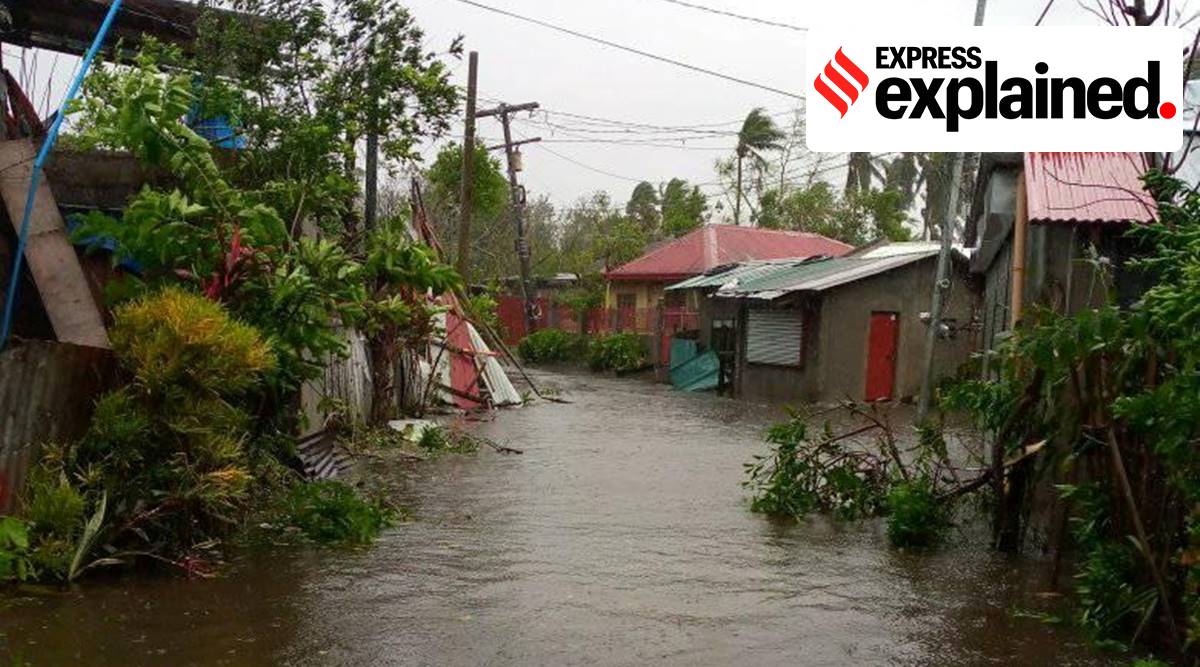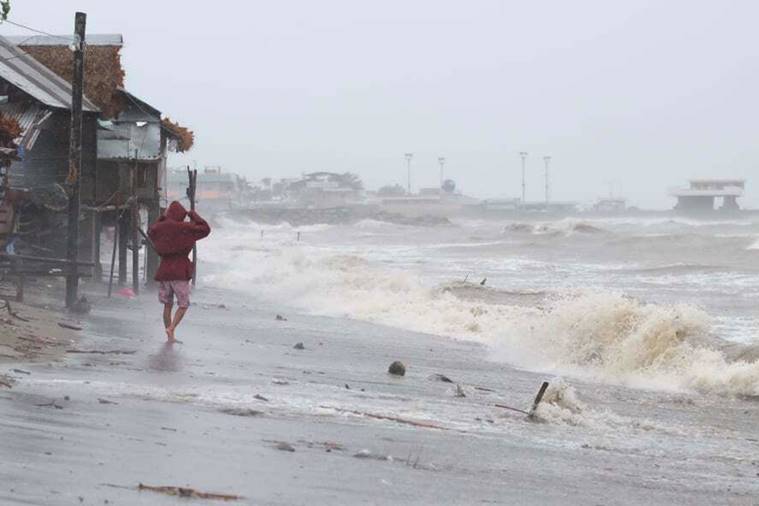 A view of floodwater and damaged houses in the aftermath of Typhoon Goni in Albay Province, Philippines, November 1, 2020, in this picture obtained from social media. (Marychris Olavario-Cuachin/via Reuters)
A view of floodwater and damaged houses in the aftermath of Typhoon Goni in Albay Province, Philippines, November 1, 2020, in this picture obtained from social media. (Marychris Olavario-Cuachin/via Reuters)
Typhoon Rolly or Goni, as it is called internationally, made landfall in the eastern Philippines on Sunday. Over a million people in the typhoon’s projected path have been evacuated, including in the capital, where the international airport is now closed. This is the 18th typhoon to hit the country this year.
How severe is Typhoon Goni?
As of now, the country’s weather bureau has downgraded the tropical storm from a Super Typhoon to a typhoon, which is maintaining wind speeds of over 215 km per hour (135 mph) near the centre and gusts of about 295 kph. As per PAGASA, the typhoon will bring light to moderate rainfall with heavy rainfall in some areas including the capital.
“Catastrophic violent winds and intense to torrential rainfall associated with the region of the eyewall and inner rainbands of the typhoon is prevailing or expected within the next 12 hours over the western portion of Camarines Sur, Marinduque, the central and southern portions of Quezon, Laguna, the eastern portion of Batangas, and Cavite. This is a particularly dangerous situation for these areas,” the weather agency said.
There are five categories of tropical cyclones, depending on the wind speeds. When winds in the rotating systems reach 39 mph, the storm is called a tropical storm and when they reach 74 mph, the tropical storm can be classified as a tropical cyclone or a hurricane and is also given a name.
 Strong waves batter the coast of Sorsogon province, central Philippines as a typhoon locally known as Goni hits the country on Sunday Nov. 1, 2020. (AP Photo)
Strong waves batter the coast of Sorsogon province, central Philippines as a typhoon locally known as Goni hits the country on Sunday Nov. 1, 2020. (AP Photo)
Once tropical cyclones make landfall, they become weaker since they are no longer fed by the heat of the ocean, but before dying out completely, they move far inland dumping inches of rainwater and causing wind damage.
What is the impact of such a typhoon?
As per PAGASA, strong winds associated with the storm have damaged high-risk structures and have partially damaged houses made with “first-class” materials. In addition, while some banana plantations have suffered total damage, coconut plantations are expected to suffer extensive damage. Rice and corn plantations also may suffer severe losses. 📣 Express Explained is now on Telegram
What is the difference between a hurricane and a typhoon?
There is no difference. Depending on where they occur, hurricanes may be called typhoons or cyclones. As per NASA, the scientific name for all these kinds of storms is tropical cyclones. The tropical cyclones that form over the Atlantic Ocean or the eastern Pacific Ocean are called hurricanes and the ones that form in the Northwest Pacific are called typhoons.
 People carry the body of a victim in the aftermath of Typhoon Goni in San Francisco, Guinobatan, Albay province, Philippines November 1, 2020. (Shyneth Occidental Montero/Handout via Reuters)
People carry the body of a victim in the aftermath of Typhoon Goni in San Francisco, Guinobatan, Albay province, Philippines November 1, 2020. (Shyneth Occidental Montero/Handout via Reuters)
What are hurricanes and how do they form?
Tropical cyclones or hurricanes use warm, moist air as fuel and therefore form over warm ocean waters near the equator. As NASA describes it, when the warm, moist air rises upward from the surface of the ocean, it creates an area of low air pressure below. When this happens, the air from the surrounding areas, which has higher pressure, enters this space, eventually rising when it becomes warm and moist too.
As the warm and moist air continues to rise, the surrounding air will keep entering the area of low air pressure. When the warm air rises and cools off, the water in the air forms clouds and this system of clouds and winds continues to grow and spin, fuelled by the ocean’s heat and the water that evaporates from its surface.
As such storm systems rotate faster and faster, an eye forms in the centre. Storms that form towards the north of the equator rotate counterclockwise and those that form south of the equator spin clockwise because of the rotation of the Earth on its axis.
"severe" - Google News
November 01, 2020 at 02:36PM
https://ift.tt/37Yg8fY
Explained: How severe is Typhoon Goni, Asia’s most powerful tropical storm of 2020? - The Indian Express
"severe" - Google News
https://ift.tt/2OrY17E
Shoes Man Tutorial
Pos News Update
Meme Update
Korean Entertainment News
Japan News Update
Bagikan Berita Ini















0 Response to "Explained: How severe is Typhoon Goni, Asia’s most powerful tropical storm of 2020? - The Indian Express"
Post a Comment